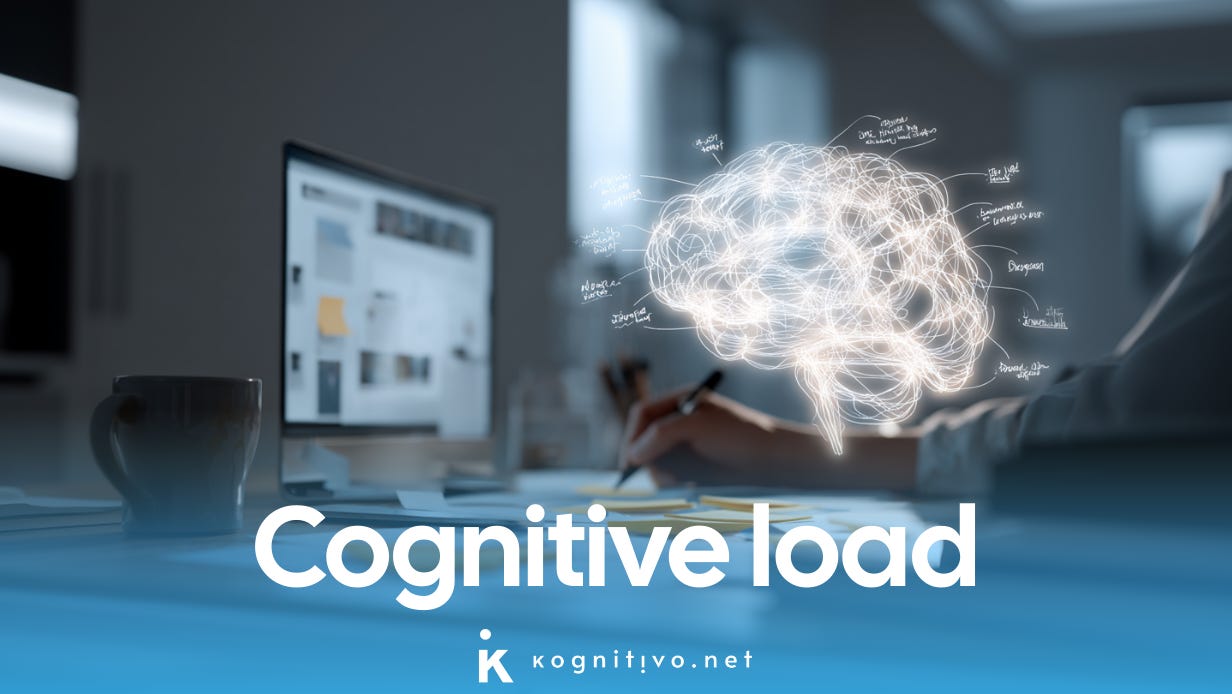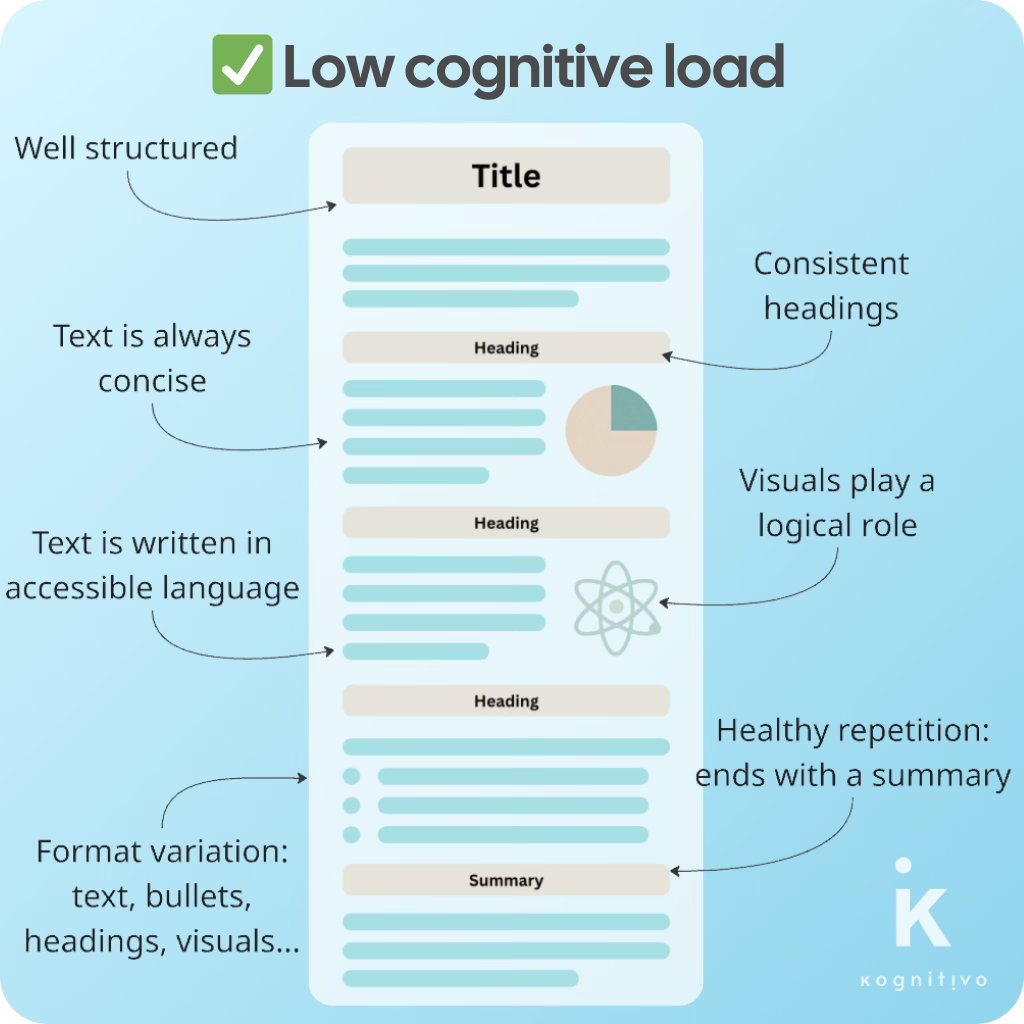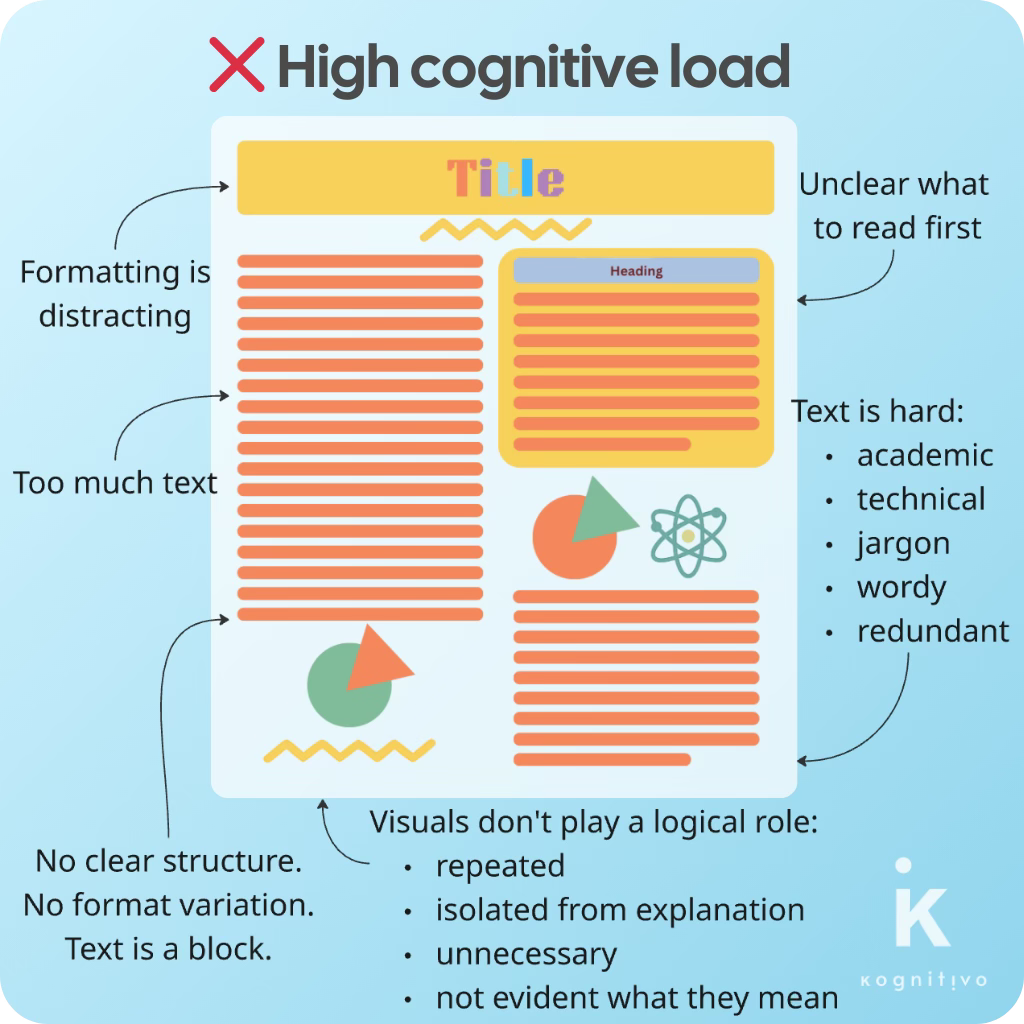Cognitive load: How much information is too much?
Think learning is about absorbing lots of information? Think again. Cognitive load is the sneaky culprit behind overwhelm and shallow learning. It explains why your old school textbook was so bad!
Ever walk to the fridge and forget why you’re there?
Or try to multitask with your phone buzzing, a podcast playing and the TV on? That’s your mental bandwidth running out!
What’s going on here has a name: cognitive load. It’s one of the most important concepts for telling apart successful learning experiences. It puts the focus on how much brain work you can do at once. Spoiler: not much!
What is cognitive load?
Cognitive load is the amount of mental effort you're using to process information, solve a problem or learn something new.
💡Analogy: Think of your brain as a computer without much RAM. Learning tasks take up RAM, and when you overload it, you freeze!
Our working memory is naturally limited in both capacity and duration. Sadly, information and knowledge can only move to long-term memory after being processed by working memory. I didn’t make the rules!
This means that even highly motivated learners like you risk confusion, mental fatigue and shallow learning when confronted with poorly designed learning experiences. Worse, you may think you are the problem (the “Am I stupid?” crisis). You probably remember that feeling from reading your old school textbook.
The solution? Reducing cognitive load.
Tip for educators and content creators:
Reducing cognitive load isn’t about making content easier.
It’s about making it learnable.
Types of cognitive load
There are three types of cognitive load:
Intrinsic load
This is the natural complexity of the task. Some concepts, tasks and processes are just harder by nature. We can’t reduce this one, but we can manage it.Doing your taxes? High intrinsic load. Making toast? Low.
Understanding the passive voice in Japanese? High. Cleaning the mirror? Low.Extraneous load
This is the unnecessary load added by external factors (extraneous = ‘external, foreign’) such as bad design, poor instructions or chaos. This is the one we want to reduce as much as possible!
Imagine a PowerPoint slide that's simply a block of text, full of spelling mistakes, no heading, no visuals and it's all written in Comic Sans. Your brain is already tired just looking at it.
Germane load
Yes, germane (not German). Germane means ‘relevant and appropriate’. This is the good kind of load: the effort spent making sense of things, making connections, and building understanding. You don’t want to reduce this one, you want to encourage and support it.
Like when you actually get how something works instead of just memorizing the steps. Compare: blindly following a recipe vs understanding how cooking works. One gives you dinner; the other makes you a chef.
How to handle cognitive load?
When we talk about reducing the cognitive load, we normally mean only the extraneous load. However, strictly speaking, cognitive load theory gives us three priorities. Whether you are a learner, an educator or a content creator, these priorities are a checklist for you to assess the quality of any learning experience… or to improve your own!
How well does the learning experience…?
Reduce extraneous load (clutter, bad design, distractions)
Manage intrinsic load (the complexity of the content itself)
Support germane load (the mental work that builds understanding)
Case: text explanations
All of that sounds great, but what does cognitive load in the wild look like?
Let’s focus on the case of reducing the extraneous load of simple text explanations. These could be:
a chapter from a textbook
a section from an e-learning course
a museum flyer
a blog post (like this one, ha!)
but also: a work e-mail
but also: a business report explaining an issue or a project
but also: a long WhatsApp message where you explain to a friend the whole story of what happened last night at the club… hour by hour
…basically any text where you explain something!
Let’s look at two generic cases: one requiring low cognitive load and one requiring high cognitive load:
Key aspects
Here’s what to focus on when assessing the cognitive load of a text:
Structure and flow: are the parts of the text clearly identifiable?
Formatting: does it support structure and add variation? is it distracting?
Length: is the text concise? how long is each paragraph?
Language: does the text avoid jargon and difficult terms?
Visuals: do visuals support learning? are they relevant?
Repetition: does it consolidate knowledge or is it redundancy?
There are also other aspects you can consider: using examples, scaffolding (first easy ideas, then difficult ones), signposting (“In this section, we will…”)… and many more.
Tip for writers:
Reducing the cognitive load of a text = improving these aspects
When looking at a text that’s optimized in all those aspects… you should even be able to understand the gist of it by only scrolling through it.
Reducing the cognitive load is the secret sauce to making “traditional” formats (like text explanations) modern, fresh and attractive. You don’t always need next-gen interactive videos to understand a topic!
What? Are you suggesting that these are the principles that I’m implementing while writing this article? I’ve been advised by my legal team to respond with a coy smile!
Cognitive load applies to everything
From lectures and videos to Instagram reels and TV shows, how content is presented either helps or hurts your brain’s ability to process it.
Next time you binge-watch, ask yourself: is the story of this TV series complex in itself (intrinsic load) or is it just poorly presented over the different episodes (extraneous load)? Arguably, the cognitive load of reels is oftentimes too low… (I said what I said)
Thank you for reading!
Next time you’re at a museum, don’t disappoint me and go all judgy when you look at the flyer: “OMG, the cognitive load here is terrible!” 💅
Did you find the topic interesting? Let me know in the comments if you’d like another post about additional cases, the intrinsic or the germane load. If you made it all the way here, you’ve got the brain bandwidth for one more move: subscribe. Or stay lost at the fridge. Your call.
And remember: no one is stupid!
#StandUpForScience
Keep learning
Prompt suggestions to nerd out with your AI chatbot
Always ask follow-up questions:
How would you encourage my germane load when understanding the concept of cognitive load?
Would you say that some people increase the cognitive load of a topic on purpose in order to “look mysterious”?
How would you reduce the cognitive load of the storytelling used in the TV series Lost? (replace with your favorite complex TV series, film or book)
Act as an educator. Here’s a text I wrote, can you give me feedback and suggestions on how to reduce its cognitive load: (insert text)
Act as an expert on educational content writing. I want to reduce the cognitive load of my text by adding examples. Can you give me 5 memorable and relatable examples for the topic “X“? My target audience is “Y”.
Act as a teacher and test me using retrieval practice on the topic of “cognitive load theory”. Ask me 5 questions, one at a time, only proceeding when I answer each one. Make the questions progressively harder.
Links
The magical number seven: Historical paper from the 50s by George A. Miller that’s usually referred to as the predecessor of the concept of cognitive load. It argues that humans can remember seven numbers at once (plus minus 2).
Cognitive load during problem solving: effects on learning: This paper published in 1988 by the incredible psychologist John Sweller is considered to be the grounding document of cognitive load theory (now as a theory). You can access it for free on this link by clicking on “PDF”.
An introduction to cognitive load theory: If you want to learn more about cognitive load theory, this website provides a great in-depth overview: I feel like it’s a wonderful next step after reading this article!
A little guide for teachers: cognitive load theory: Here’s a book recommendation for teachers who want to implement cognitive load theory in their lessons!





